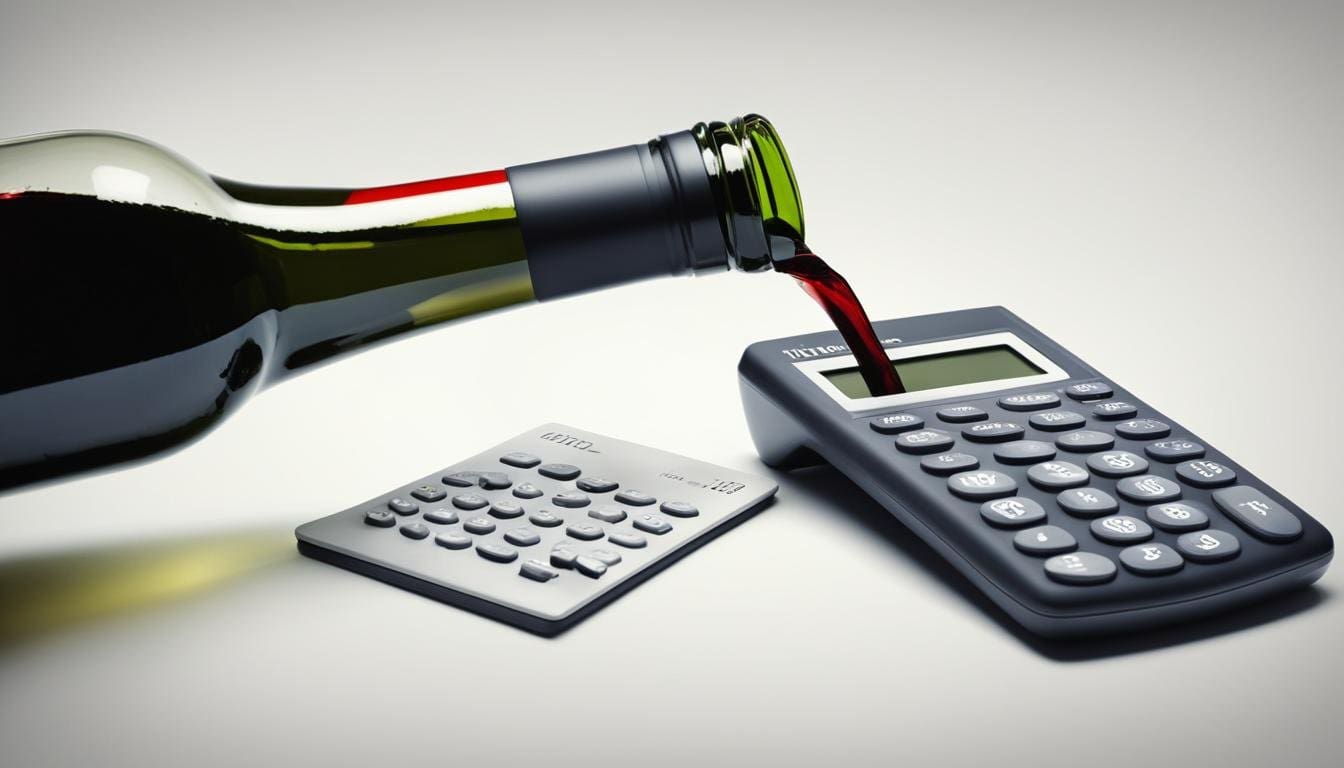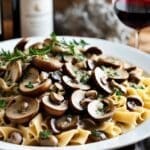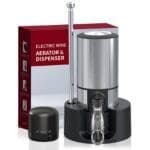This post may contain affiliate links. Please read my disclosure policy.
Are you intrigued by the delightful dance of calories swirling about in that fancy glass of Shiraz or Chardonnay? Fair dinkum, it’s a curious ballet of energy in each sip that often escapes our gaze, simply because nutrition facts on vino bottles are as scarce as hen’s teeth. But fear not, for those keen on wine and weight loss, or merely curious connoisseurs, we have the skinny on the calories in wine.
It’s time to uncork the mystery and pour out the truth – within that seemingly innocent 150 ml tipple of goodness, you might be sipping on something between 100 to 160 calories. The figures can fluctuate like the Aussie dollar, and it’s primarily dependent on the wine’s alcohol by volume (ABV) which isn’t always evident at a glance. So, whether you’re a casual sipper or a devout oenophile, it’s prudent to have a reliable wine calorie calculator at your beck and call to keep tabs on your daily intake.
Key Takeaways
- A standard 150 ml serve of wine can range from 100 to 160 calories.
- The ABV of wine greatly affects calorie content, so keep an eye out.
- Nutrition labels on wine bottles are rarer than a quiet pub, but necessary for informed sipping.
- Wine lovers on a diet, having a wine calorie calculator might just be your new best mate.
- For those balancing wine with waistlines, knowledge is power and portion control is key.
- With no signpost of calories on bottles, be vigilant with your serves during a cheeky wine night.
Check out our Wine Calorie Calculator!
Understanding Calories In Wine
Embarking on a calorie-conscious journey needn’t mean giving the cold shoulder to a delightful glass of Shiraz or a sprightly Riesling. As much as we love a good yarn over a bottle, it’s the numbers behind those wine calories—those grappling with the intricacies of calories in red wine, calories in white wine, and overall wine calorie content—that have us raising our eyebrows, not just our glasses. Knowledge, as they say, is power, especially when it comes to understanding just what’s behind that velvety mouthfeel or crisp finish.
The Source of Calories in Wine
When it comes to the curious case of calories in our beloved fermented grape juice, there’s a duo responsible for the tally: carbohydrates and alcohol. But it’s not as straightforward as bread versus beer. In wine, carbs appear as residual sugar, lingering after the grapes have been danced over by the yeast during fermentation. Every gram of this sweet serendipity adds a modest 4 calories to your glass.
How Residual Sugar Influences Wine’s Calorie Content
Drier than a kangaroo’s pouch in a drought are your low-cal vinos, mates. A decrease in residual sugar means a drop in the calorie count. If you’re savouring a tipple that doesn’t tip the sweetness scale, you’re likely enjoying fewer calories in your twirl-and-sniff routine. On the flip side, a wine that could double as a dessert with its sugar levels will undoubtedly sport a higher calorie score.
Alcohol’s Role in Wine Calorie Numbers
Now, don’t let your taste buds deceive you; there’s more to wine calories than sugar alone. Alcohol, the life of the party, contributes a whopping 7 calories per gram, silently escalating the calorie content in that innocuous glass of wine. Think of it as the sneaky critter in the room, not easily spotted but definitely there, merrily adding to the calorie content.
Sitting pretty at around 147 grams, the standard wine serving sends a clear message to wine enthusiasts: mind the volume. It’s not just about the percentage of ABV or the sweetness you favour, but how generously you fill that glass. A bit extra here or there, and those calories will be on the rise quicker than the mercury on a scorching summer day in the outback.
A word to the wise: oak-aged vinos might just impart a few extra calories, courtesy of the wooden embrace during maturation. So, whether it’s a glass of wine that’s velvety red or almost ethereal in its paleness, being calorie-savvy is all part of the oenophilic voyage.
Calories in Different Types of Wine
Strewth! If you’ve ever found yourself wondering, “how many calories in a glass of white wine?’ you’re not alone. It’s no secret that the caloric content in our cherished bottle of plonk varies as much as the weather in Melbourne. Thankfully, knowledge is as free as a bird, and we’re here to suss out the nitty-gritty of wine calories, whether you’re counting them or just mildly curious. So let’s dive into the truth behind the numbers in your glass.
On the lighter end of the scale, we’ve got your low calorie wines, like a spritely glass of Prosecco—which is, quite frankly, like a summer’s breeze in your mouth—averaging a modest 90 calories. This is akin to a quick surf session rather than a triathlon of calorie burning. Then you’ve got your calories in a glass of red wine, with choices like Merlot and Cabernet Sauvignon clocking in at around 83 calories per cheeky 100 ml pour—a fair go for the red aficionados who like a tipple without the topple on the scales.
Now, if you fancy something a bit sweeter, take a bib, ’cause calories in sweet wine jump up faster than kangaroos at sunrise. A glass of Moscato might have you reeling with its up to 365 calories per 100 ml. A number that could have you frothing at the mouth if you’re vigilant about counting calories in wine. It’s not quite a meal in a glass, but it’s sure trying to be.

| Wine Type | Calories per 100 ml | Calories per 150 ml glass |
|---|---|---|
| Prosecco | 90 | 125 |
| Merlot | 83 | 116 |
| Cabernet Sauvignon | 83 | 116 |
| Moscato | 365 | 511 |
For those of us watching the waistline but wanting to wet the whistle, it’s worth taking a gander at wines that won’t make our pants tighter. Choosing dry whites or reds with fewer boozy kicks is a good shout. At the end of the day, a little Aussie know-how goes a long way in making smart sips, so you can still enjoy the odd glass of vino without throwing your dieting efforts down the gurgler.
How to Enjoy Wine Smartly on a Calorie-Controlled Diet
Aussies have long had a love affair with a quality drop, but navigating the blurred lines between wine appreciation and managing the belt buckle can be as tricky as chook on a hot tin roof. Fear not, mates! There are savvy ways to relish your Shiraz and keep those pesky calories in check. Roll up your sleeves and prepare to get acquainted with the wine calorie calculator, a tool that might just become your new best cobber.
Smart sip tip number one: check out the alcohol content in wine. Your favourite plonk’s ABV is the ringleader when it comes to calorie content. A drop with less alcohol usually means a skinnier calorie count. Not to say you have to ditch the goon entirely, but picking a lower ABV can help keep things trimmer than a surfer’s waistline.
Choosing Wine by the Alcohol by Volume (ABV)
If you’re dead set on wine and weight loss, the ABCs of ABV are your new alphabet. Aim for vinos lounging underneath the 12.5% mark, giving the cold shoulder to those hefty numbers like 14.5% or more. It’s all about that magic balance – enjoying a brilliant tipple without it bulking out your calorie count card.
Opting for Low-Sugar Wine Varieties
Next up, let’s get the lowdown on low-sugar wines. Those delightfully dry varieties that don’t come packed with the sugary wallop found in their sweet cousins are the ticket. These subdued sippers not only dodge the risk of a pounding head the morning after but also keep the calorie tally in the green zone.
Portion Control: Wine Serving Sizes Matter
Last but certainly not least: portion size. Keeping to the 150 ml standard for your wine servings is as crucial as a good meat pie at the footy. By steering clear of supersizing your sips, you’ll sidestep the sneaky calorie creep and keep your diet as neat as a button.
Put all this together, and what have you got? A strategy as sturdy as a Sydney Harbour bridge for enjoying your vinous pleasures while keeping an eagle eye on those calories. So, next time you’re contemplating a bottle from the land down under or any fine wine, for that matter, remember these tips. Stay informed, drink responsibly, and enjoy the ride – cheers to that!
Conclusion
It’s fair dinkum that the joy derived from a cheeky glass of vino is as rich as the soil in the Barossa Valley. But for those with an eye on their health and waistline, wrapping your head around the calories in wine is as vital as sunscreen at a Boxing Day Test. By understanding the subtle foxtrot between sugar content and ABV in our wines, we can navigate our calorie intake as gracefully as a koala scales a eucalyptus.
When it’s about minding those wine calories, knowing your low-calorie wines from the pack is as good as having a map in the Outback. This savviness doesn’t mean you have to give the flick to a good drop; just make a bluey’s choice for wines on the lighter side of the scale – those without the punchy ABV and dragging sugar levels. Gravitating towards wines that boast transparency in their nutritional makeup is also akin to choosing a clear path through the bush, ensuring you can savour a tipple without the trepidation of unknown calories.
Ultimately, true blue wine lovers can rest easy knowing that an informed sip is the best sip. As more winemakers lift the lid on their wine calorie content, folks can continue attending their beloved BBQs and dinner parties, wine glass in hand, full of trust that each pour aligns with their personal targets. So here’s to the good times, the fine wines, and keeping all things in balance — chin chin!
Source Links
- https://usualwines.com/blogs/knowledge-base/how-many-calories-in-a-glass-of-wine
- https://home.binwise.com/guides/calories-in-wine
- https://www.calories.info/food/wine
Sip smarter, subscribe now!
Subscribe for gourmet tips, event updates, travel ideas, and a free e-book on Food Pairings. Start your journey to culinary and travel excellence!















